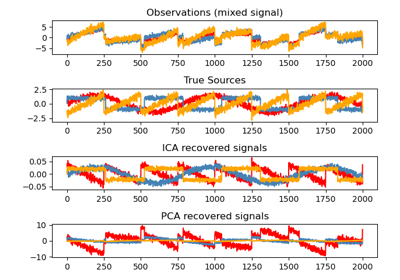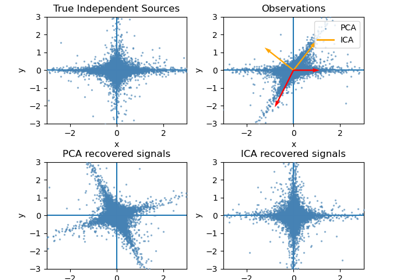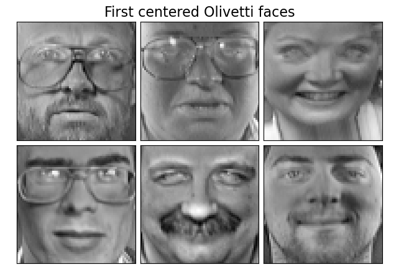sklearn.decomposition.FastICA¶
- class sklearn.decomposition.FastICA(n_components=None, *, algorithm='parallel', whiten=True, fun='logcosh', fun_args=None, max_iter=200, tol=0.0001, w_init=None, random_state=None)[source]¶
FastICA: a fast algorithm for Independent Component Analysis.
The implementation is based on [1].
Read more in the User Guide.
- Parameters
- n_componentsint, default=None
Number of components to use. If None is passed, all are used.
- algorithm{‘parallel’, ‘deflation’}, default=’parallel’
Apply parallel or deflational algorithm for FastICA.
- whitenbool, default=True
If whiten is false, the data is already considered to be whitened, and no whitening is performed.
- fun{‘logcosh’, ‘exp’, ‘cube’} or callable, default=’logcosh’
The functional form of the G function used in the approximation to neg-entropy. Could be either ‘logcosh’, ‘exp’, or ‘cube’. You can also provide your own function. It should return a tuple containing the value of the function, and of its derivative, in the point. Example:
def my_g(x): return x ** 3, (3 * x ** 2).mean(axis=-1)
- fun_argsdict, default=None
Arguments to send to the functional form. If empty and if fun=’logcosh’, fun_args will take value {‘alpha’ : 1.0}.
- max_iterint, default=200
Maximum number of iterations during fit.
- tolfloat, default=1e-4
Tolerance on update at each iteration.
- w_initndarray of shape (n_components, n_components), default=None
The mixing matrix to be used to initialize the algorithm.
- random_stateint, RandomState instance or None, default=None
Used to initialize
w_initwhen not specified, with a normal distribution. Pass an int, for reproducible results across multiple function calls. See Glossary.
- Attributes
- components_ndarray of shape (n_components, n_features)
The linear operator to apply to the data to get the independent sources. This is equal to the unmixing matrix when
whitenis False, and equal tonp.dot(unmixing_matrix, self.whitening_)whenwhitenis True.- mixing_ndarray of shape (n_features, n_components)
The pseudo-inverse of
components_. It is the linear operator that maps independent sources to the data.- mean_ndarray of shape(n_features,)
The mean over features. Only set if
self.whitenis True.- n_features_in_int
Number of features seen during fit.
New in version 0.24.
- feature_names_in_ndarray of shape (
n_features_in_,) Names of features seen during fit. Defined only when
Xhas feature names that are all strings.New in version 1.0.
- n_iter_int
If the algorithm is “deflation”, n_iter is the maximum number of iterations run across all components. Else they are just the number of iterations taken to converge.
- whitening_ndarray of shape (n_components, n_features)
Only set if whiten is ‘True’. This is the pre-whitening matrix that projects data onto the first
n_componentsprincipal components.
See also
PCAPrincipal component analysis (PCA).
IncrementalPCAIncremental principal components analysis (IPCA).
KernelPCAKernel Principal component analysis (KPCA).
MiniBatchSparsePCAMini-batch Sparse Principal Components Analysis.
SparsePCASparse Principal Components Analysis (SparsePCA).
References
- 1
A. Hyvarinen and E. Oja, Independent Component Analysis: Algorithms and Applications, Neural Networks, 13(4-5), 2000, pp. 411-430.
Examples
>>> from sklearn.datasets import load_digits >>> from sklearn.decomposition import FastICA >>> X, _ = load_digits(return_X_y=True) >>> transformer = FastICA(n_components=7, ... random_state=0) >>> X_transformed = transformer.fit_transform(X) >>> X_transformed.shape (1797, 7)
Methods
fit(X[, y])Fit the model to X.
fit_transform(X[, y])Fit the model and recover the sources from X.
get_params([deep])Get parameters for this estimator.
inverse_transform(X[, copy])Transform the sources back to the mixed data (apply mixing matrix).
set_params(**params)Set the parameters of this estimator.
transform(X[, copy])Recover the sources from X (apply the unmixing matrix).
- fit(X, y=None)[source]¶
Fit the model to X.
- Parameters
- Xarray-like of shape (n_samples, n_features)
Training data, where
n_samplesis the number of samples andn_featuresis the number of features.- yIgnored
Not used, present for API consistency by convention.
- Returns
- selfobject
Returns the instance itself.
- fit_transform(X, y=None)[source]¶
Fit the model and recover the sources from X.
- Parameters
- Xarray-like of shape (n_samples, n_features)
Training data, where
n_samplesis the number of samples andn_featuresis the number of features.- yIgnored
Not used, present for API consistency by convention.
- Returns
- X_newndarray of shape (n_samples, n_components)
Estimated sources obtained by transforming the data with the estimated unmixing matrix.
- get_params(deep=True)[source]¶
Get parameters for this estimator.
- Parameters
- deepbool, default=True
If True, will return the parameters for this estimator and contained subobjects that are estimators.
- Returns
- paramsdict
Parameter names mapped to their values.
- inverse_transform(X, copy=True)[source]¶
Transform the sources back to the mixed data (apply mixing matrix).
- Parameters
- Xarray-like of shape (n_samples, n_components)
Sources, where
n_samplesis the number of samples andn_componentsis the number of components.- copybool, default=True
If False, data passed to fit are overwritten. Defaults to True.
- Returns
- X_newndarray of shape (n_samples, n_features)
Reconstructed data obtained with the mixing matrix.
- set_params(**params)[source]¶
Set the parameters of this estimator.
The method works on simple estimators as well as on nested objects (such as
Pipeline). The latter have parameters of the form<component>__<parameter>so that it’s possible to update each component of a nested object.- Parameters
- **paramsdict
Estimator parameters.
- Returns
- selfestimator instance
Estimator instance.
- transform(X, copy=True)[source]¶
Recover the sources from X (apply the unmixing matrix).
- Parameters
- Xarray-like of shape (n_samples, n_features)
Data to transform, where
n_samplesis the number of samples andn_featuresis the number of features.- copybool, default=True
If False, data passed to fit can be overwritten. Defaults to True.
- Returns
- X_newndarray of shape (n_samples, n_components)
Estimated sources obtained by transforming the data with the estimated unmixing matrix.



